To grill or not to grill, that is the question.
Whether it is better to pack a picnic lunch or to buy a stainless propane barbecue—and in doing so assume the initial cost, the work of setting it up and keeping it clean and free from corrosion—rests on just how important grilling is to you. While the benefits of marine grills are largely existential, the pitfalls tend to be concrete, like layers of baked-on grease. These things get dirty, they rust, and they require bottled propane, which can be a storage hazard on boats.
To get a sense of what you can expect from marine-grill ownership, we tested six propane-fired, stainless steel models; four are rectangular grills with hinged, fold-back hoods, and two are kettles.
We looked at barbecues from Magma, Force 10, Tasco, Dickinson, and Sport Barbecues, and found that the price range was not as varied as the range in quality, from the metalwork to the mounting hardware. PS testers evaluated each grill for heat distribution, mount stability in a swell, ease of cleaning, and quality of construction. For test details, see the “PS Turns Up the Heat” sidebar.
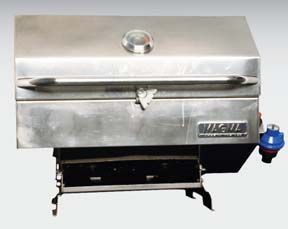
Magma Catalina
The Catalina from Magma ($300) is the most expensive grill in the test group. For that you get pristine, mirror-polished stainless steel, a fractional grill face that is easy to clean, and a warming rack above the grill. The Catalina was the only test grill with a warming rack. It also has a color-coded temperature gauge, but serious grillers would be more interested in a numeric gauge.
The Catalina has an annoying latch below its long, stainless hood handle that caught several times on the bottom half of the grill during our cook test. The latch is good for securing the grill and keeping its contents contained, but its tendency to engage at the wrong time could result in some mournfully blackened beef.
The gas regulators used on the Catalina and Magma’s kettle-style grill use the same “bayonet” system as the other grills, but they allow the regulators to be rotated while in use. Most of the test grills have fixed regulators, but the Magmas’ are detachable. This makes it easier to screw on propane bottles and allows quick access to the propane jet for cleaning.
Heat distribution tests showed that the Catalina has no persistent hot or cold spots, but testers had a hard time bleeding off heat once it got into the red.
The mounting hardware is secure but wobbled some when the test boat was rocked. The rod holder mount has the added feature of an adjustable ball joint that controls the grill’s angle.
Bottom Line: The Catalina is a high-quality grill with great metalwork and some nice features. We’d like to see a numerical thermometer and a redesigned latch.
Force 10 Sea Grill 180

The Force 10 Sea Grill 180 is in many ways comparable to the Catalina, but it’s $60 cheaper. Its polished stainless, numeric temperature gauge, and unobtrusive hood latches are its finer points. The Force 10 is slightly larger than the Catalina and produces 1,000 more BTUs, but it was clear that both these grills produce more than enough heat for their size. As with the Catalina, we had a tough time taming the Force 10 during our cook-off. Our heat distribution test showed a slight hot spot in the front of the grill face, and a cool spot in the back.
The Force 10 lacks the Catalina’s warming rack and fractional grill. However, its mounting hardware is the easiest to use in the test field. The Force 10 uses four thumbscrews that attach the shore stand, rod, and rail mounts. No tools are required, and set-up is fast and simple.
In the stability test, the rail mount was secure; however, the wobbly rod-holder mount held the grill off-angle, causing grease to build up near the burner.
The Force 10 fared well in our salt-water spray test, which speaks to its quality construction. Its mounting hardware did not develop rust.
Bottom Line: The Force 10’s high BTU output and reluctance to dissipate heat require the chef to keep a watchful eye, a comment that can be applied to all of these grills but is more pronounced in the Force 10 because it has the most umph. However, the Force 10 is a big, high-quality grill and costs less than the Catalina. Its metalwork is just as good, in our estimation, and its latches, numeric thermometer, and thumbscrew hardware are unmatched features.
Dickinson Sea-B-Que
The Sea-B-Que ($260) from Dickinson Marine is a rectangular grill with a hinged top that is half the size of both the Force 10 and the Catalina. It is more expensive than the Force 10 and offers considerably less capacity and fewer features.
The brushed stainless Sea-B-Que did not fare well in our spray test. Corrosion quickly formed on at the corners and weld points.
The Sea-B-Que’s mounting hardware required the most assembly, with several very small screws holding its painted metal mounting bracket together. Once the bracket is installed, though, it slides in and clips to the rod holder mount easily. The rail mount requires additional assembly and quite a few small pieces that fumbling fingers could drop overboard.
The Sea-B-Que features a numeric thermometer, which PS prefers, and a fractional ceramic rack, which was the easiest to clean of the group. The drawback is that the metal beneath the ceramic likely will rust once the coating chips. Our heat-distribution dough test showed a marked cold spot in the front center of the grill face, and temperature control was a problem because of the Sea-B-Que’s high BTU output and compact volume.
Bottom Line: Though compact and solidly built, the Sea-B-Que is overpriced, in our opinion. It would be a good value—cute, even—if its price tag was sharply reduced and setting up the rail mount wasn’t such a pain.
Tasco Seacooker
The rectangular grill with a hinged lid from Tasco was the bottom-end performer in our test. Though slightly larger than the Sea-B-Que and of similar brushed stainless, the Tasco showed more corrosion around its rivets and had an obvious hot spot on the grill face. Testers attributed this hot spot (in the front half) to several factors: too many BTUs, an elaborate but ineffective heat shield above the burner, and a regulator that allowed for more intense flaming at the beginning of the burner that dissipated toward the end of the closed loop. During our cook-off, the intense heat melted rubber bushings on the inside of the hood, around the screws attaching the handle, spoiling that batch of burgers.
The rail mount was also problematic: It placed the grill too far off the rail, creating a diving-board effect during the roll test. While it was easy to install with only a few steps to mount it, its lack of mounting fasteners made it less stable.
Bottom Line: The Tasco is manufactured by the Massachusetts-based Taunton Stove Co., which specializes in larger, more elaborate stoves. Its marine grill does not measure up to the competition, in our view.
Magma Kettle vs. Sport Extreme Kettle
In the kettle stoves face-off, Magma’s Marine Kettle beat Sport Barbecues’ Extreme Kettle with more capacity, higher BTU output, and higher-quality metal construction.The Magma kettle also offers the most flexibility in grill height when it is mounted, but its plated-steel rail mount showed significant corrosion after our saltwater spray test.
Corrosion on the Sport Extreme was even more pronounced, with extreme deterioration around the kettle’s underbelly and the ignitor. The metal attachment holding the ignitor to the kettle rusted completely off, leaving the ignitor dangling by its wire.
Both kettles were more susceptible to wind, which caused uneven heat distribution, than their rectangular counterparts; both developed a hot spot in the left front quadrant during our test.
Cleanup is easier with the Sport Extreme because it has a removable grease tray. The Magma does not, making regular cleanup more labor intensive.
Both kettles would benefit from more deeply set racks to cut down on food falling overboard, a problem rectangular grills don’t have.
Bottom Line: At $180, the Sport Extreme is about $20 cheaper than the Magma. This difference boils down to the quality of materials, and the Magma’s stainless steel construction is certainly worth it if you want a grill for the long haul. The Sport Extreme’s corrosion was much more pronounced.
Conclusion
In the marine grills’ race, it comes down to quality. If you’re going to spend $200 or $300 on a marine grill, you want one that will last. Of the big rectangular units, the Force 10 Sea Grill 180 and the Magma Catalina are equally well-made. Does the Catalina’s warming rack, fractional grill and easy to install propane fitting make it worth $60 more than the Force 10, with its numeric thermometer, simple latches, and convenient thumbscrews? That depends on how you plan to use the grill.
The final ratings came down to the pizza dough test. Our Best Choice, the Catalina showed fairly even heat distribution, while our Budget Buy, the Force 10, had some hot spots.
We’d need to see the prices of the smaller brushed stainless rectangular grills drop before we’d consider picking one up. Mirror-polished stainless steel, while requiring more fuss to keep it shiny, does a better job resisting rust. PS found the bodies of the Sea-B-Que and Tasco more prone to rust stains and more difficult to clean. The Magma’s mounting hardware was also affected.
If you want a smaller grill than the Catalina or the Force 10, opt instead for the Magma kettle, our Best Choice in the kettles category.
Unless you need it for just one season, we would not recommend buying the Sport Extreme because of its tendency to corrode quickly.
Also With This Article
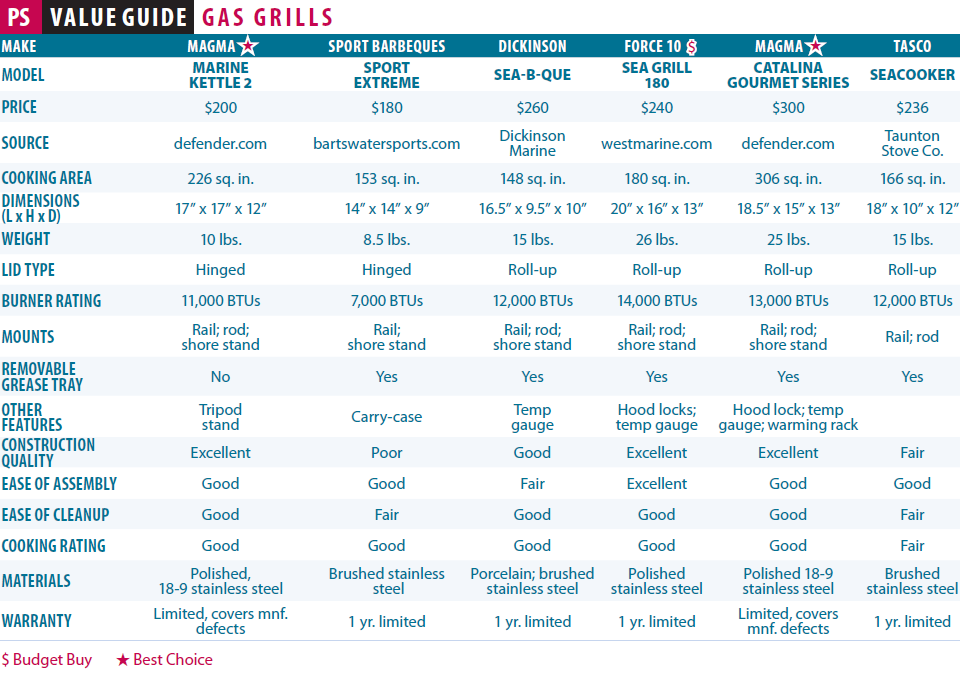
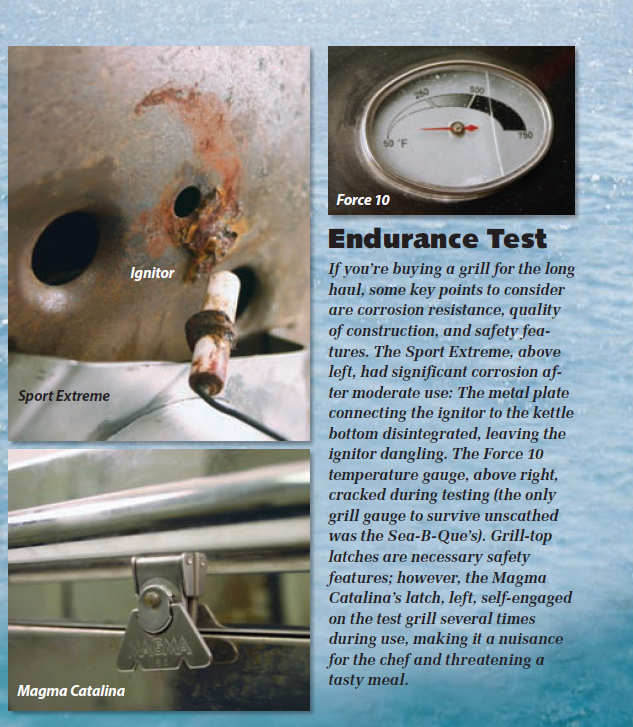
Temperature control was a problem for all the grills we tested. In our opinion, they all produce too many BTUs for their size. Temperatures get out of hand— in the 600s—once the grease starts to fly, so grillers should work slowly up to desired temps. All grills were fueled with Coleman propane in 16.4-ounce bottles.
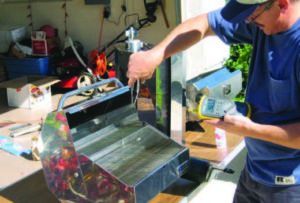
We wanted to see how clean we could get the test grills using just soap, water, and a non-abrasive sponge—a quick clean between uses, not a complete overhaul. We found that the grill racks could be cleaned easily, but the hardened grease inside the grill body required more effort. Fractional racks are really the only innovation that makes cleaning easier because the smaller pieces can be completely submerged in a bucket or sink. Two grills in our test, the Magma Catalina and the Dickinson Sea-B-Que, have them.
These stainless grills often show discoloration after the first use. This is not corrosion, but rather chromium oxide formed from a chemical reaction with oxygen when the metal is heated. Brushed stainless, used on the Sea-B-Que, Sport Extreme, and the Tasco, is more susceptible. The polished stainless grills will retain most of their luster on the exterior but will be discolored on the inside. Greasy smoke will stain these grills as it escapes through the spaces on the grill body. Because the stainless-steel grill bodies are easily scratched, oven cleaner is needed for an all-out clean. The chemical cleaner must be thoroughly rinsed off before the grill is used again. This may require some disassembly to be sure your next meal is not tainted with chemicals.
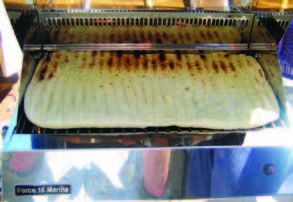
chromium oxide formed from a chemical reaction with oxygen when the metal is heated.
To get a sense of the grills’ tendency to corrode, we sprayed the outside of each unit and its mounting hardware with salt water for seven days without rinsing off the salt spray. We also looked at each grill’s mounting hardware in terms of security and ergonomics. In our view, the mounting system should provide for a stable grilling surface parallel to the horizon and high enough off the deck to make grilling comfort- able. It should also be relatively easy to assemble and disassemble. Each grill was mounted with its rail and rod-holder hardware on our test boat to determine ease of installation. To estimate each grill’s performance in a swell, testers conducted a roll test by vigorously rocking the boat in its slip.
Contacts
• Dickinson Sea-B-Que, 800/659-9768, www.dickinsonmarine.com
• Force 10, 604/522-0233, www.force10.com
• Magma, 562627-0500, www.magmaproducts.com
• Si-Port II (sport extreme), 604/888-2939, www.sportbbq.com
• Taunton Stove Co. (Tasco), 508/823-0786, www.tauntonstove.com
































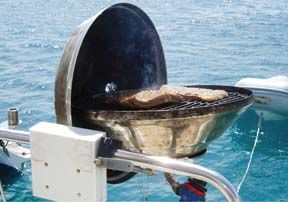





I have been using this highly affordable and portable cookbox with built-in handles for easy carriage and storage. It’s easy to remove and stow and has adequate space for preparing food while on the water, docked, or camped.